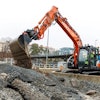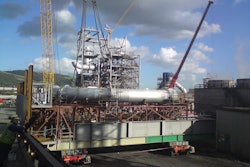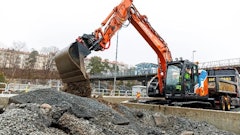The market that lies ahead in the next few years will be very different to the past: and the scenario that analysts depict varies in relation to geographic reference areas, with only one certainty: Europe is no longer at the center of the world. The CECE Congress concluded recently in Berlin generated many interesting facts, especially those presented by Off-Highway research. Only five years ago, in 2007, the world market achieved peak sales with a total volume of around 100 billion dollars. Two years later, at the height of the recessionary crisis, sales barely came to 55 billion dollars. Since then, a slow recovery has begun that brought market volumes in 2011 to 109 billion dollars. Unfortunately, 2012 will close with a downturn of about 10% which, analysts suggest, will be followed by a new expansion phase that by 2016 could well lead to volumes of around 121 billion dollars.
Prudence is essential, since it is by now evident that no one is able to say exactly what will happen over a time scale of more than 12 months without abandoning the role of analyst to take on that of a oracle. There are simply too many variables: mention need only be made of the United States and the risk of a 600 billion dollar "fiscal cliff" in 2013 alone (envisaged in the agreement for raising the 2011 debt ceiling in order to balance public finances; the measure involves automatic spending cuts and a generalized increase in taxation, with the expiry of Bush-era benefits for the wealthy and an end to those on workers, ed.) that re-elected President Obama must avert by next December 31, on pain of losing several GDP points in the US economy precisely now that even the local construction industry seems to be showing some signs of recovery. An event that almost certainly would have a chain reaction effect on other economies around the world. This already complex scenario is joined by another factor of uncertainty: the new distribution of market weighting.
In particular, Europe in 2007 "weighed in" with approximately 20 billion dollars for construction machinery but at the end of 2012 will only have posted 12 billions. Within this market, Italy in 2007 had a market share of 16% but today only 9%. On the contrary, China has almost tripled from 11 billion dollars five years ago to over 31 billions in 2012, although, its own market is currently down in the wake of economic intervention by the Chinese Government worried by a possible bubble in an economy that is still growing very fast. In any case, after taking machinery worth 11.2 billion dollars in 2007, the Asian giant's home market in this sector will stabilise by 2016 at around 38.5 billions to become by far the planet's largest market. India is also booming and over the time period analysed has grown from 1.9 to 5.4 billions, while North America is expected to return to 2007 levels of between 27 and 28 billion dollars.
According to Off-Highway analysts, the future will see a market where Europe is essentially stagnant, albeit with significant differences among its member countries, and the rest of the world which - despite uncertainties - will grow gradually yet constantly but without reaching the peaks that characterized some markets in the past.
In this context, the Secretary-General of CECE, Ralf Wezel, offered food for thought, "It may still be possible and competitive for our sector to produce in Europe, given the scientific and technological heritage available in certain industrial areas and certain research and innovation institutes. European legislators, however, have to understand that European industry must be defended and supported in order to safeguard the hundreds of thousands of jobs it currently ensures. We need a European industrial policy that addresses the gaps still extant in the internal market; as regards emission reductions, we must implement a holistic approach equally guided by the market and ensure fair competition, especially in relation to the so-called grey imports which are causing major economic damage to our industry."
Giampiero Biglia, a member of the CECE Steering Committee and Vice-President of Unacea, points out, "By the end of the year in Italy, sales of construction machinery will be down by one-third compared to the previous year. In such a situation, after five years of crisis, even good export performances are not enough. The construction machinery industry absolutely must be involved in a serious plan to help the sector recover. The foundations, in terms of competitiveness and product quality, are already in place."
“CECE's conferences are interesting moments for meetings and comparisons for European construction industry machinery producers," says the President of Ucomesa, Luca Turri, "and this year, given the ongoing difficulties in the sector and the evolution of the global context, CECE was determined to provide a venue for discussing the topic of 'making it in Europe,' that is investigating the future scenarios for such production in Europe. This is a very topical issue which the Congress sought to provide, if not answers, at least some outlines. I personally think that the highlighted importance of maintaining and even strengthening production capacity in Europe, basing its competitiveness on research and development. Proof of this approach is the major interest among producers from outside Europe in acquisitions that link not only to the market but also to important know-how."


















